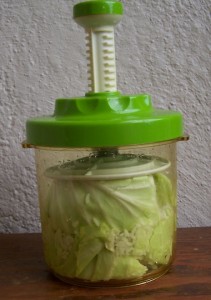Quarter lengthwise a head of won bok (Chinese cabbage), or regular head cabbage. Remove the bulky part of the head if possible.
Salt sparsely- preferably with Hawaiian sea salt, but common table salt will do. Massage salt into cabbage chunks. Cabbage should be limp. Rinse and drain if desired (optional).
Put cabbage (should be soft from being salted) into bowl, add some (a tablespoon or more) cooked rice to the bowl. We used to use the burnt rice at the bottom of the pot that no one wanted to eat. Adding rice adds a nice folksy flavor to the tsukemono, and is also optional (but deliciously advised).
If using those plastic contraptions with the screw down lid, you will limit the amount of cabbage you can pickle at a time because they are rather small. Put the slightly salted cabbage with rice in, screw down as much as you can, and cover. Check and screw down often.
Or, use a large glass or pyrex bowl and arrange the cabbage so it is an even layer. Turn a glass or ceramic plate upside down to press down on the entire layer of cabbage, and put a weight on the plate. You can also use a juice bottle filled with water to act as the weight.
After a few days, you will see liquid in the bowl with the cabbage. This is the fermenting process happening. Keep screwing the lid tighter to keep compressing the cabbage. After a few days you can remove the cabbage, rinse off the rice, squeeze out excess water, chop, and then enjoy with your rice!
Experiment with other vegetables such as eggplant, mustard cabbage, daikon, etc. Some vegetables need to be cut thin in order to ferment evenly. Remember to salt prior to putting in bowl in order to make the vegetable soft and wilty.

